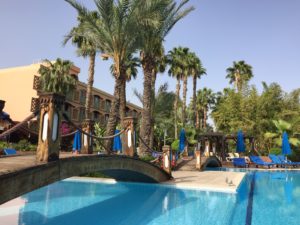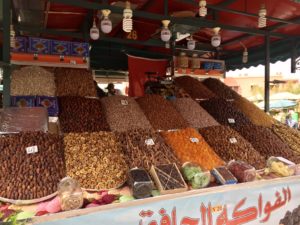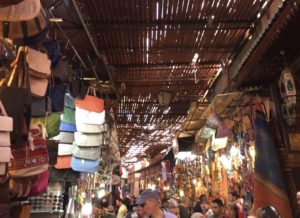Introduction
Marrakech the third largest city in Morocco and lies near the foothills of the snow-capped Atlas Mountains. Its popularity as a travel destination is due to many things to do in Marrakech. This Marrakech travel guide discusses the cultural sights, bustling souks, luxury riads, delicious foods, and access to many multi-day trips such as the Atlas mountains and Sahara Desert.
The city is separated into two parts: the Medina, the historical city, and Ville Nouvelle, the modern district. The Medina is where all the interesting action is at with its intertwining narrow passageways, riads, souks, hustle, and bustle.

Getting There
If traveling from Europe, there are many Ryan Air flights they fly direct to Marrakech. If flying from the US or other international destinations, likely a layover in Casablanca is required.
It is best to coordinate transport to and from the airport with the hotel or riad you are staying with. This is especially true if you are staying in the Medina, which is like a maze that even locals can get lost in. For this trip, my tour operator offered to pick me up and drop me off at the hotel at no extra cost.
Places to Stay
Stay in the Medina at a Riad! Its truly a unique experience to stay in a Riad, which is a traditional Moroccan house or palace with an interior garden or courtyard. Riads vary in size and price from a 4 bedroom house to a palatial sized accommodation with up to 20 rooms.
I ended up staying at the Riad Aguerzame which was smaller but more intimate, included breakfast, had great staff, delicious food, and was beautifully decorated with Moroccan architecture. Relaxing in the courtyard and on the roof desk was very enjoyable and refreshing.

If you want to save some cash and have spare SPG points, the Le Méridien N’Fis is only 3,000 points per night! It is located outside of the Medina but has well landscaped property, large pools, and great food.

Things to Do
Djemaa El-Fna Square
Visiting Djemaa El-Fna square is an absolute must while in Marrakech, as its one of the largest most stimulating city squares. Upon arrival, your greeted by snake charmers, people with monkeys, dancers, and musicians. There are all kinds of stands selling fresh food, street food, pottery, clothing, leather bags, and anything else you can image.
During the day, enjoy some coffee from one of the roof top cafes and people watch. In the evening, Djemaa El-Fna square really comes alive with hordes of people, drums beating, and street food cooking everywhere. Its the place to be at night.



The Souks
The souks (markets), are located near Djemaa El-Fna and seemingly go on forever. Getting lost is an inevitability and a welcomed part of the experience. I visited to souks on 3 separate days and stumbled upon new large undiscovered areas on each visit. You can buy almost anything such as carpets, spices, tea pots, lanterns, shoes, leather products, chickens, and tagines.
Being an inexperienced bargainer, I undoubtedly ended up paying higher prices than the locals. Never pay the initial offered price and counter at about 60% to 80% less. The whole walking out routine seems to work but the whole song and dance bargaining routine to get a lower price becomes tiresome. If purchasing expensive items, haggle back a forth and walk out, it could save you hundreds of dollars.
There are state run shops outside of the Medina that sell products at fixed prices. This is a good way of getting a price baseline for certain products. In my experience, the fixed priced items are about 30% to 100% more expensive than the Medina where bargaining is required. If you don’t want to deal with crowds or haggling, the state run shops are a good option.
Be sure to bring large luggage to carry home all the items you are likely to buy.





Medina
The Medina is the ancient section of the city with endless labyrinths and hundreds of alley ways just wide enough to fit a donkey and cart. Most of the Medina is not able to fit automobile traffic, however, there are plenty of people, motorbikes, carts, and donkeys traveling every which way.
Also, the Medina is where to stay in a Riad, a Moroccan house with an internal courtyard. Most windows in the riad face inward to the central courtyard. Riads do not display any wealth on the exterior. However, once inside, its a different story where intricate designs, artistry, and luxurious furnishings can all be found on display. Its quite fun walking around the Medina and peering into any of the open riads to get a peek of the interiors.



El Badi Palace
The ruins of El Badi palace was built by Sultan Ahmed al Mansour to celebrate the victory of the Portuguese army in 1578. Underground passageways can be explored with excellent city views from the terrace. Entrance Fee: 10 dirhams.


Ben Youssef Madrassa
Ben Youssef Madrassa is one of the largest Madrassas in the North Africa built in 1570. The art and architecture is amazingly detailed and beautiful. Entrance Fee: 40 dirhams.


Dar Si Saïd Museum
Dar Si Saïd Museum is in a old palace that includes many Moroccan artifacts including musical instruments, pottery, ceramics, carpets, clothing, and weapons. Entrance Fee: 10 dirhams.

Saadian Tombs
The tombs remained untouched for hundreds of years and have remained largely intact. Inside the tombs you will find an insane amount of detailed carvings and an abundance of Zelij Morrocan tiles. The time and patience required to carve these tombs is unimaginable. Entrance Fee: 10 dirhams.


Koutoubia Mosque
Koutoubia mosque is like the Eiffel Tower of Marrakech. It was constructed in 1190 and has inspired other buildings such as the Giralda of Seville in Spain. Non-Muslims are not permitted inside but can walk around the beautiful gardens.

City Walls and Gates
The old town Medina in Marrakech is surrounded by ancient walls with 19 gates constructed during Almohad dynasty in the 12th century. A good way to tour the outer walls and gates is by taking a horse carriage tour around the major sights in Marrakech.

Horse Carriage Ride
Taking a horse carriage ride is a great way to tour parts of the Medina, the outer walls, and the new city without dealing with the crowds of people and long walks. Prices are negotiable (do the whole walking away thing to lower the price).

Outside Marrakech
- Atlas Mountains (Day Trip)
- Essaouira (Day Trip)
- Ait Ben Haddou Kasbah (Multi-Day Trip)
- Dades Valley (Multi-Day Trip)
- Merzouga Desert Camel Trek (Multi-Day Trip)

What to Eat
Morocco has some of the best tasting unique food in the world and coming across a bland dish is nearly impossible. Be sure to try mint tea, various tagines, kefta, couscous, pastilla, lentil soup, and briouat.
Use tripadvisor.com to find good restaurants or ask your hotel for some recommendations. I prefer to to eat inside the riad I’m staying at or find another riad nearby since I find the food to have a more home cooked quality. Plus, the local Moroccan atmosphere inside a riad cannot be beat.





Conclusion
In conclusion, Marrakech should certainly be at the top of anyone’s bucket list. Between the historical sights, wonderful shopping opportunities, delicious food, low cost, and many potential side trips, Marrakech certainly has no shortage of exciting experiences. If you have been traveling all throughout Europe and everything is starting to look the same, Marrakech provides a unique and distinct travel experience well worth the visit.

Related Posts:
- Top 10 Countries to Visit
- Travel Guide: Moroccan Desert
- Travel Guide: Jordan
- Travel Guide: Muscat, Oman
- Travel Guide: Masai Mara National Reserve, Kenya
- Travel Guide: Samburu National Reserve, Kenya
- Travel Guide: Havana, Cuba
- Travel Guide: Seoul, Korea
- Travel Guide: Saigon, Vietnam
- Travel Guide: Southern Italy
- Travel Guide: Prague, Czech Republic












1 comment